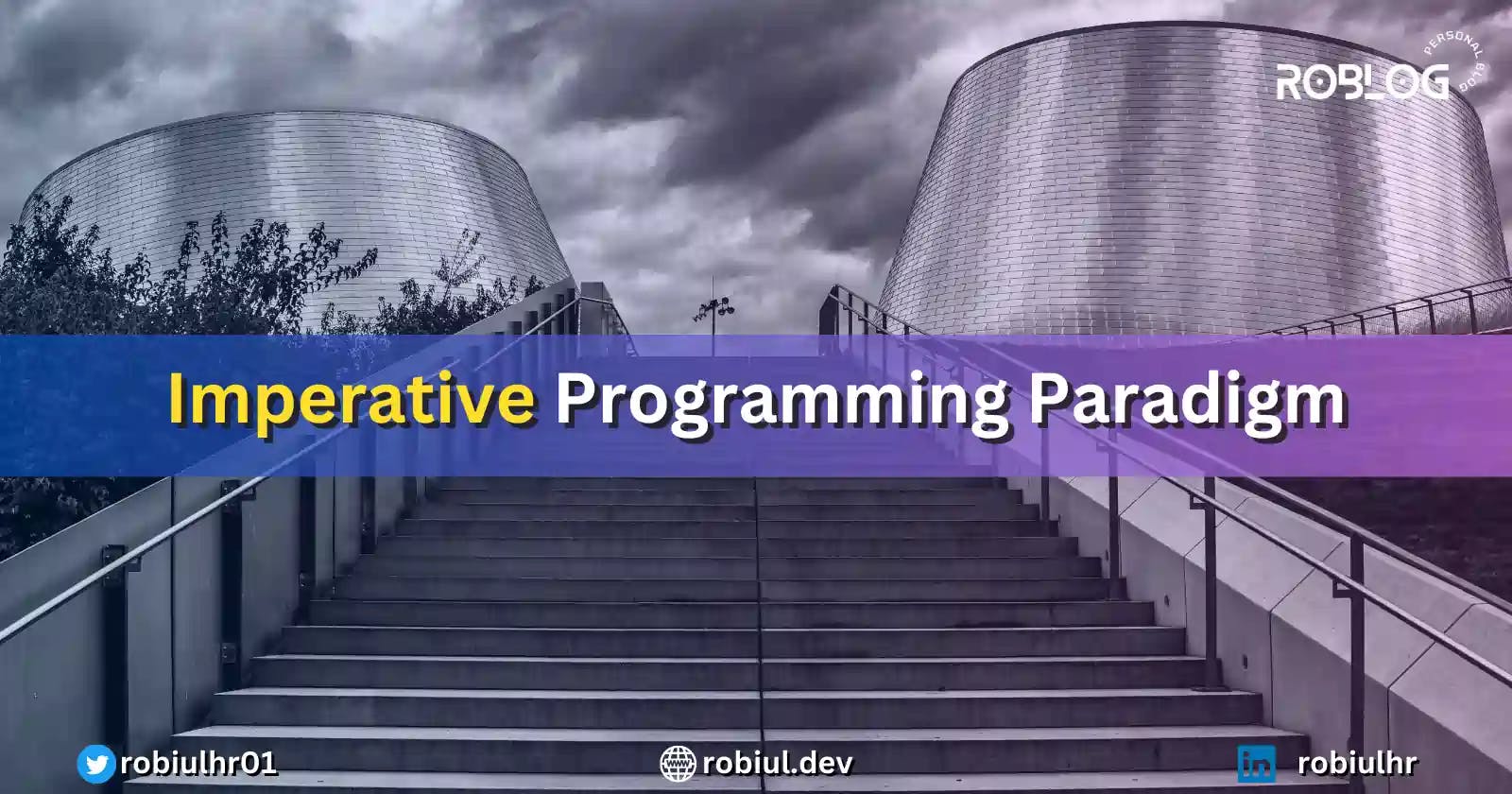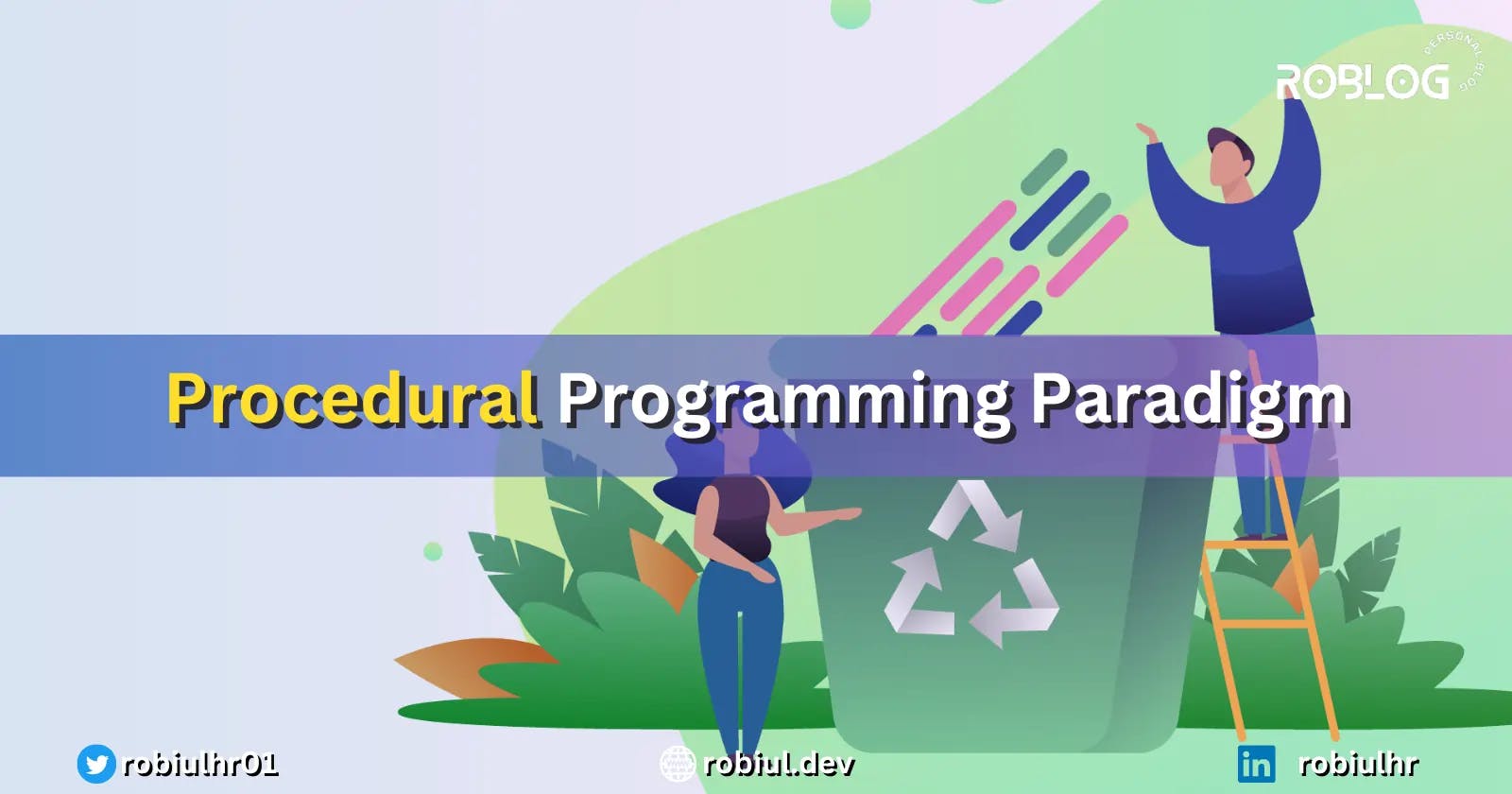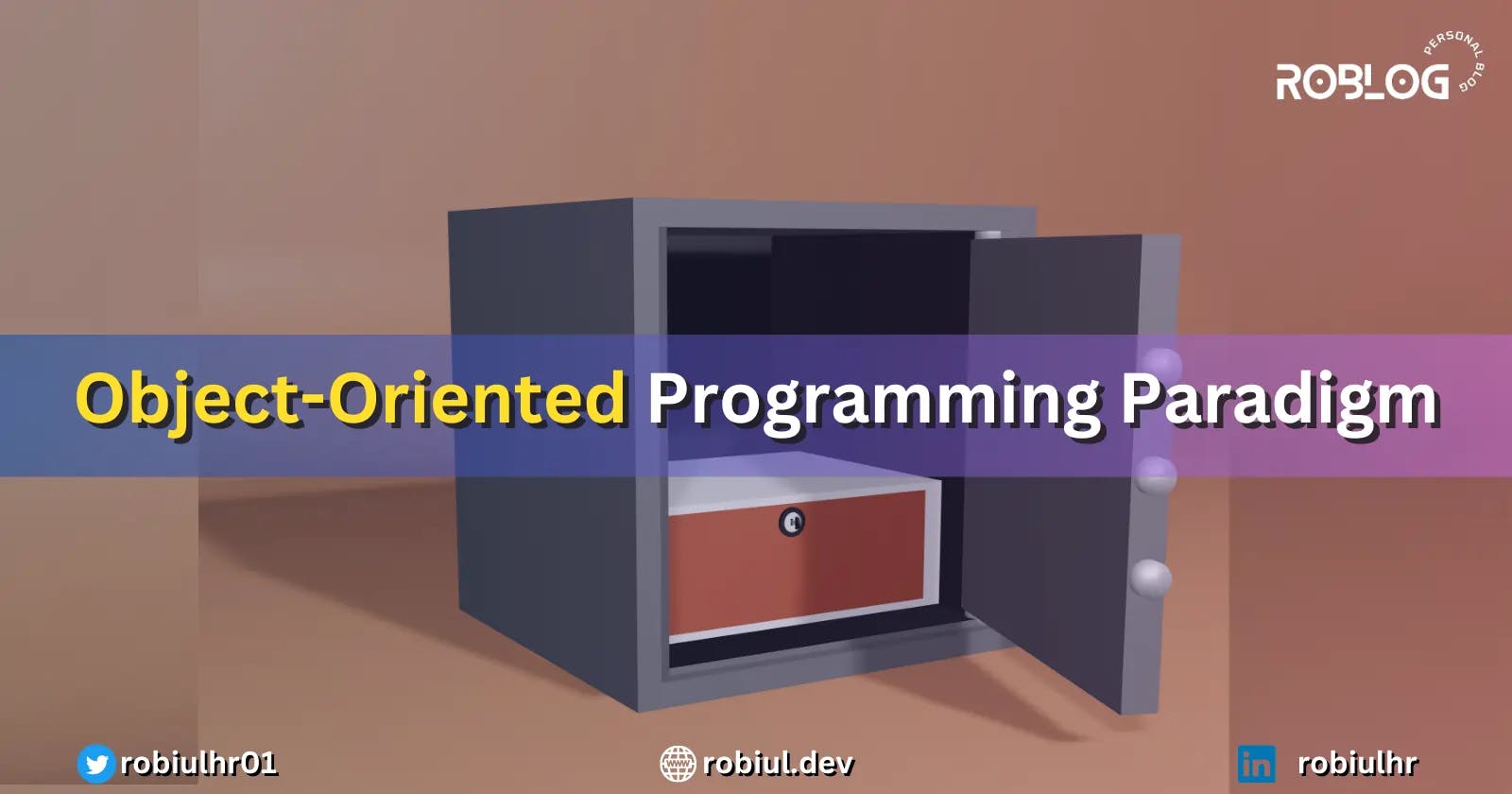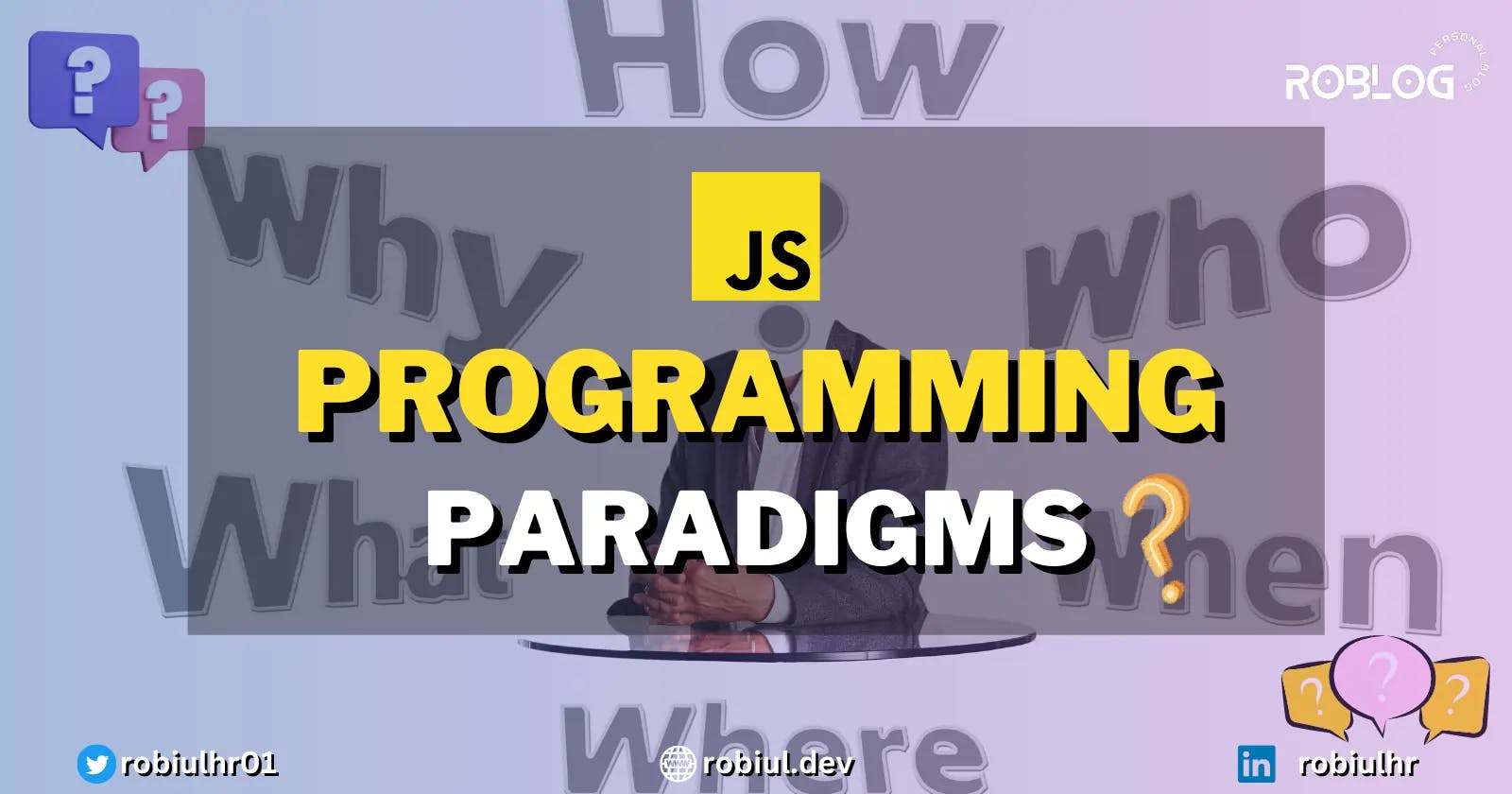What are Programming Paradigms? - Master all Popular Ones
Understand the Foundations of Software Development - All you need to know about Programming Paradigms
Table of contents
- Introduction
- What are Programming Paradigms?
- What Programming Paradigms are Not?
- Why should I care?
- Types of Programming Paradigms
- Understanding the Major Programming Paradigms
- Importance of Choosing the Right Paradigm
- How to Choose the Right Paradigm
- Misconceptions about Programming Paradigms
- Conclusion
- Resources
Introduction
Have you ever found yourself wondering what people mean when they talk about 'object-oriented programming' or 'functional programming'? These terms can sound confusing and leave you scratching your head, unsure of their true meaning.
Well, fret not! In this article, I am here to make things crystal clear. We'll dive into the world of programming paradigms and explain these concepts in plain and simple language. We'll explore popular paradigms like object-oriented programming and functional programming, breaking them down into easy-to-understand ideas.
By the end of this article, you'll have a clear understanding of these programming paradigms and be able to join the conversation with confidence. No more confusion or feeling left out when people mention these terms!
Whether you are a seasoned developer or just starting your programming journey, this exploration of programming paradigms will broaden your horizons and empower you to think creatively and tackle complex problems with confidence.
So, Let's jump right in and explore this exciting world together!
What are Programming Paradigms?
Programming paradigms are different ways or approaches that programmers use to write code. Just like there are various ways to approach everyday tasks, such as cooking or building, there are different approaches to coding.
Think of programming paradigms as different sets of instructions or strategies that programmers follow to solve problems and build software. Each paradigm has its unique characteristics and principles that guide how code is organized and structured. These different approaches yield the same result but involve different ways of thinking and organizing the process.
To better understand this concept, let's consider the process of making a cup of coffee.

When making coffee, you can approach it in different ways, just like programming paradigms offer different approaches to coding. When making a cup of coffee, you can follow a set of step-by-step instructions, where each action is explicitly defined (imperative approach).
You measure the water, grind the coffee beans, heat the water to a specific temperature, pour the water over the coffee grounds, and finally, enjoy your cup of coffee.
Each action is explicitly defined, and you have full control over every step of the process.
On the other hand, Alternatively, you can describe the desired outcome without specifying each step (declarative approach).
You simply state that you want a cup of coffee. This approach focuses on the end result rather than the specific instructions. The coffee machine takes care of the process, determining the water temperature, grind size, and other details to achieve the desired outcome.
In this case, someone else, like the coffee machine, has already defined how the process of making coffee should be done. These different approaches yield the same result—a cup of coffee—but involve different ways of thinking and organizing the process.
In the declarative approach, the responsibility for executing the detailed steps lies with someone else or a pre-existing system.
Similarly, programming paradigms offer different ways to tackle coding challenges. Some paradigms focus on specifying explicit instructions (imperative), while others prioritize describing the desired outcome (declarative). Each paradigm offers its own benefits and considerations.
What Programming Paradigms are Not?
Besides understanding what programming paradigms are, it is equally important to know what programming paradigms are not. This clarity is especially crucial for new programmers to avoid confusion and misconceptions.
This Understanding will help you approach the subject with a clearer perspective, appreciating the strengths and limitations of each paradigm.
Firstly, a programming paradigm is not a specific programming language or a strict set of rules. It's not a one-size-fits-all solution or a magic trick for solving every programming problem effortlessly.
Instead, think of programming paradigms as shared ways of thinking and organizing code. They're like guiding principles and ideas that programmers agree upon and follow.
Secondly, programming paradigms are not a strict progression or separate categories. They can coexist within a programming language or project. Developers often mix and match different paradigms based on their software's needs.
Programming languages are not always tied to a single paradigm. Some languages are designed for a particular paradigm, but many languages allow you to adapt your code to fit different paradigms.
It's important to understand that using a specific programming paradigm doesn't guarantee good or bad code. The quality of code depends on factors like the developer's skills, best practices, and coding standards, regardless of the paradigm used.
Remember, programming paradigms are flexible frameworks, not strict rules, allowing you to navigate the programming landscape and make informed decisions in your coding journey.
Why should I care?
To answer this question in short, Programming paradigms are essential general knowledge for developers.
However, if we delve into a more detailed explanation, we discover that Exploring programming paradigms is not only interesting but also crucial for expanding your understanding of different approaches to programming. It goes beyond the usual tools and techniques, encouraging you to think creatively and explore new problem-solving strategies.
You've probably come across terms like object-oriented programming (OOP) or functional programming in the coding world. Having a basic understanding of programming paradigms helps you grasp these concepts and enhances your overall comprehension of programming.
Ever wondered why there are so many programming languages out there?
Understanding programming paradigms holds the key to unraveling this mystery.
Each paradigm represents a unique philosophy and set of principles that shape how developers think and solve problems.
For example, in OOP, developers focus on modeling real-world objects and their interactions. They use concepts like encapsulation, inheritance, and polymorphism to organize their code and promote code reuse.
Embracing OOP allows for a modular and intuitive approach to development, enabling developers to analyze problems based on objects and relationships. This flexibility in thinking and problem-solving is highly valuable in the dynamic field of software development.
Developers who embrace different paradigms become more adaptable and can tackle challenges from various perspectives. They have a wider range of tools at their disposal, allowing them to choose the most suitable paradigm for a specific task or even combine paradigms to create powerful solutions.
Types of Programming Paradigms
While there are multiple programming paradigms, we can categorize them into two major groups:
Imperative Paradigms: Imperative paradigms focus on explicitly defining step-by-step instructions to manipulate the program state.Declarative Paradigms: Declarative paradigms focus on describing the desired outcome or result, rather than explicitly specifying the steps to achieve it.
Almost all major programming paradigms have a main concept of either instructing the computer step-by-step or describing the desired outcome and they can be broadly categorized as either imperative or declarative.
However, every programming paradigm comes in different flavors, each with its own unique ideas, benefits, and challenges.
But in this article, we will mainly focus on understanding the imperative and declarative nature of programming paradigms to make it simple to understand.
Understanding the Major Programming Paradigms
So far, we have discussed what programming paradigms are and why they matter.
Now let's explore a few of them...

Note: Keep in mind that this list is not complete, as there are other programming paradigms beyond what we'll cover here. However, we will focus on the most popular and widely-used ones.
Imperative Programming Paradigm
Imperative programming serves as the foundation for many programming paradigms. It consists of sets of detailed instructions that are given to the computer to execute in a given order.
It's called "imperative" because as programmers, we dictate exactly what the computer has to do in a very specific way.

Imperative programming focuses on explicitly defining step-by-step instructions to manipulate the program state. Programs are composed of a sequence of statements that change the variable's values and control flow. Imperative programming provides a basic structure for other paradigms to build upon.
Let's consider the following coding problem to understand more:
Problem: Given an array of integers, find the average of these numbers.
We can solve this problem using different programming paradigms, such as imperative, procedural, object-oriented, functional, and declarative programming.
In imperative programming, we would iterate over the array, keeping track of the sum and count of the numbers encountered. We can use a loop and an accumulator variable to update the sum.
Here's an example solution in JavaScript:
const numbers = [10, 20, 30, 40, 50];
let sum = 0;
let count = 0;
// Iterate through each element in the numbers array
for (let i = 0; i < numbers.length; i++) {
// Accumulate the sum of the numbers
sum += numbers[i];
// Increment the count of elements
count++;
}
// Calculate the average by dividing the sum by the count
const average = sum / count;
// Output the calculated average
console.log(average);
Here we define the necessary variables, sum, and count, and initialize them both to 0. We then proceed with a loop that iterates through each element in the numbers array.
Inside the loop, we accumulate the sum of the numbers by adding each element to the sum variable, and simultaneously increment the count variable to keep track of the number of elements encountered.
Once the loop completes, we calculate the average by dividing the accumulated sum by the count of elements. The result is stored in the average variable.
Finally, we output the calculated average to the console using console.log(average).
In this imperative solution, we're focusing on describing "how" to perform tasks providing detailed and specific instructions to the program. We are We explicitly iterate through each element in the array, accumulate the sum, and keep track of the count.
Imperative programming languages, such as C, Pascal, or Python, follow a step-by-step approach to execute code. Developers provide explicit instructions to the computer, specifying exactly how to perform each task. This level of control and specificity allows for fine-grained manipulation of program state and enables precise control over program flow.
Imperative programming is particularly useful in scenarios where detailed control is required, such as low-level programming, algorithm implementation, or situations where efficiency is a primary concern.
However, it can sometimes result in verbose and complex code, especially for large-scale applications. Therefore, it is important to strike a balance between explicit instructions and code readability when employing imperative programming.
Procedural Programming Paradigm
Procedural programming is a programming paradigm that focuses on breaking down a program into a set of procedures or functions. It emphasizes dividing the program into smaller, manageable chunks of code that can be executed in a specific order.

It is closely related to imperative programming and can be considered a subset of it. Procedural programming extends imperative programming by introducing the concept of functions or procedures. It still shares the fundamental idea of providing step-by-step instructions to the computer, specifying the precise sequence of actions to be performed.
One of the key advantages of procedural programming is its emphasis on code modularity and reusability. By breaking the program into separate procedures or functions, developers can create reusable blocks of code that can be called from different parts of the program.
This promotes code organization, simplifies maintenance, and reduces code duplication. Procedures encapsulate a set of instructions, making the code more manageable and easier to understand.
Procedural programming provides a structured approach to program design and works well for problems that can be divided into logical, sequential steps. It allows developers to focus on specific tasks or subroutines, making it easier to reason about and debug the code.
Here's an example that demonstrates procedural programming using the previous problem of calculating the average of a list of numbers:
function calculateAverage(numbers) {
const sum = sumNumbers(numbers);
const count = numbers.length;
const average = sum / count;
return average;
}
function sumNumbers(numbers) {
let sum = 0;
for (let i = 0; i < numbers.length; i++) {
sum += numbers[i];
}
return sum;
}
const numbers = [10, 20, 30, 40, 50];
const result = calculateAverage(numbers);
console.log(result);
In this example, we define the calculateAverage function that takes an array of numbers as input. Instead of calculating the sum and count within the calculateAverage function as we did in the imperative paradigm, we introduce a separate function sumNumbers that calculates the sum of the numbers.
The calculateAverage function calls the sumNumbers function to obtain the sum, calculates the count using the length of the numbers array, and then calculates the average by dividing the sum by the count.
By breaking down the problem into reusable functions, procedural programming promotes code modularity and reusability. Each function has a specific responsibility, making the code easier to understand and maintain.
Procedural programming is commonly used in languages like C, Pascal, and Fortran.
However, many modern languages, including Python and JavaScript, also support procedural programming alongside other paradigms, allowing developers to choose the most appropriate approach for their projects.
Object-Oriented Programming Paradigm
One of the most popular and widely used programming paradigms is object-oriented programming (OOP). It focuses on representing real-world entities as objects and organizing code around these objects.

It provides a way to structure programs by grouping related data and behavior into objects, which are instances of classes. Object-oriented programming builds upon the foundations of imperative and procedural programming.
It takes the concept of breaking down a program into smaller, reusable parts (functions or procedures) and extends it to objects, which encapsulate both data and behavior.
Objects in OOP act as self-contained entities that can communicate and interact with each other through well-defined interfaces. This enhances code organization and promotes reusability, allowing for more modular and maintainable codebases.
In the object-oriented paradigm, objects are the fundamental building blocks. An object encapsulates data (known as attributes or properties) and behaviors (known as methods) that operate on that data. Objects interact with each other through method invocations and can communicate by sending messages.
OOP introduces the concept of classes, which are blueprints for creating objects. A class defines the structure and behavior of objects, including their attributes and methods. Objects are instances of classes, meaning they are created based on the class definition.
Note: There are multiple types of OOP paradigms such as Prototype-based, and class-based.
Key concepts in Object-Oriented Programming include:
Encapsulation: Encapsulation is like putting related things together in a box. It keeps some information private and provides a way to interact with it through a public interface.Inheritance: Inheritance is like passing down traits from parents to children. It allows new classes to inherit properties and behaviors from existing classes.Polymorphism: Polymorphism is like using the same word to mean different things in different contexts. It allows objects of different types to be treated as if they were the same type.Abstraction: Abstraction is like simplifying something complex. It focuses on the important parts while hiding unnecessary details.
Here's an example that demonstrates the Object-Oriented Programming Paradigm using the previous problem of calculating the average of a list of numbers:
class AverageCalculator {
constructor(numbers) {
this.numbers = numbers;
}
calculateAverage() {
const sum = this.sumNumbers();
const count = this.numbers.length;
const average = sum / count;
return average;
}
sumNumbers() {
let sum = 0;
for (let i = 0; i < this.numbers.length; i++) {
sum += this.numbers[i];
}
return sum;
}
}
const numbers = [10, 20, 30, 40, 50];
const calculator = new AverageCalculator(numbers);
const result = calculator.calculateAverage();
console.log(result);
In this Object-Oriented Programming example, we define a class AverageCalculator that represents a calculator object for calculating the average of a list of numbers. The class has a constructor that takes an array of numbers as input and assigns it to the numbers property.
It also defines two methods: calculateAverage() to calculate the average and sumNumbers() to calculate the sum of the numbers. We create an instance of the AverageCalculator class by passing the numbers array to the constructor.
Then, we call the calculateAverage() method on the instance to obtain the average.
Finally, we log the result to the console. In this OOP approach, we encapsulate the data (the numbers array) and the behavior (the calculation methods) within the AverageCalculator class.
By creating an instance of the class, we can perform average calculations on different sets of numbers, promoting reusability and modularity.
Object-Oriented Programming provides a modular and extensible approach to software development. It allows for the creation of reusable code components, enhances code organization, and facilitates the modeling of complex systems.
OOP is widely used in languages such as Java, C++, and Python to build robust and scalable applications.
Declarative Programming Paradigm
Declarative programming is a programming paradigm that focuses on expressing the desired outcome or result, rather than specifying the exact steps to achieve it. It's all about hiding away complexity and bringing programming languages closer to human language and thinking.

It contrasts with imperative programming, where the programmer provides instructions on how to execute a task. In declarative programming, the emphasis is on what needs to be achieved, leaving the implementation details to the underlying system or framework.
This paradigm utilizes declarations, constraints, and high-level abstractions to describe the problem domain and define the desired behavior. It encompasses various sub-paradigms such as functional programming, logic programming, and database query languages, each with its unique characteristics.
Key features of declarative programming include its focus on specifying the desired result, expressing constraints and relationships, employing high-level abstractions, promoting code reusability, and emphasizing data transformations over direct state manipulation.
Let's take the example of calculating the average of a list of numbers to demonstrate the declarative programming paradigm:
const numbers = [10, 20, 30, 40, 50];
const sum = numbers.reduce((acc, num) => acc + num, 0);
const average = sum / numbers.length;
console.log(average);
In this example, we use the reduce method, a higher-order function in JavaScript, to declaratively calculate the sum of the numbers in the array. We provide a callback function that defines the accumulation logic. The reduce method iterates over each element of the array, updating the accumulator by adding the current element's value.
Finally, we divide the sum by the length of the array to calculate the average.
See that with the reduce function, we're not explicitly telling the computer to iterate over the array. We just say what we want ("reduce") and update the accumulator by adding the current element's value.
By utilizing higher-order functions and method chaining, this declarative programming approach allows us to express complex computations concisely. The focus is on describing the desired result (the sum and average calculation) rather than specifying the step-by-step procedure.
One of the advantages of declarative programming is its ability to improve code clarity, reusability, and maintainability. By separating the problem description from the implementation details, declarative programming enhances code readability and reduces the likelihood of introducing bugs.
It enables programmers to express computations as a composition of functions and transformations, promoting code organization and comprehension.
Note: It's important to note that while declarative programming hides away the complexity of implementation details, the computer still processes the information using imperative code.
Functional Programming Paradigm
Functional programming is another widely used programming paradigm, closely related to declarative programming and often considered a subset of it.

Functional programming treats functions as first-class citizens, enabling them to be assigned to variables, passed as arguments, and returned from other functions. This paradigm focuses on immutability, pure functions, and higher-order functions.
Pure functions are fundamental in functional programming. They solely depend on their inputs to produce results and have no side effects. Regardless of the context, a pure function will always produce the same output for the same input. This enhances code reliability and predictability.
Functional programming languages like Haskell, Lisp, and JavaScript (with libraries like React) promote the use of functions as first-class citizens and encourage a declarative and concise coding style. The paradigm discourages mutable state and data modification, promoting code reliability and predictability.
Functional programming emphasizes higher-order functions, which provide flexibility and enable function composition and reusability. By emphasizing modularity and avoiding side effects, functional programming makes it easier to identify and separate responsibilities within the codebase, improving code maintainability.
Taking the example of calculating the average of an array, we can demonstrate the functional programming approach:
const numbers = [10, 20, 30, 40, 50];
// Function to calculate the average
const calculateAverage = (arr) => {
const sum = arr.reduce((acc, num) => acc + num, 0);
const count = arr.length;
return sum / count;
};
// Calculate the average using the functional approach
const average = calculateAverage(numbers);
console.log(average)
In this functional programming example, code is almost the same as the declarative paradigm, but we wrap our iteration within a function called calculateAverage. It uses the reduce method to calculate the sum of the numbers in the array and then divides it by the length of the array to obtain the average.
The calculateAverage function is a pure function as it solely depends on its input and produces a predictable output without modifying any external state. This promotes code reusability, modularity, and easier testing.
By encapsulating the logic within the calculateAverage function, we ensure that it doesn't modify anything outside its scope. It processes its information within the function and doesn't have any side effects on the surrounding code.
Functional programming encourages writing programs primarily using functions. By promoting code modularity, immutability, and the absence of side effects, functional programming enhances code reliability and maintainability.
Importance of Choosing the Right Paradigm
Choosing the right programming paradigm can seem pointless to beginners at times.
After all, most paradigms can work fine for many scenarios, and getting the work done is the primary objective. However, selecting the appropriate paradigm involves considering various factors beyond immediate functionality.
Paradigms have a significant impact on code management, project extensibility, code performance, and other aspects of software development. Merely achieving the desired outcome is not enough reason to choose a paradigm. It's crucial to evaluate how well the paradigm aligns with the project requirements and long-term goals.
A well-suited paradigm can improve code organization, maintainability, and readability. It can provide the necessary structure for future scalability and ease of maintenance.
Additionally, certain paradigms may optimize code performance, making it more efficient and resource-friendly.
Therefore, it's essential to weigh the pros and cons of different paradigms and assess their compatibility with the project's specific needs. It's not just about making the work done; it's about selecting the paradigm that can best address the broader aspects of software development and contribute to the success of the project.
How to Choose the Right Paradigm
After knowing the importance of choosing the right paradigm, you may wonder how to choose the right paradigm for your project or development needs.
It is essential to acknowledge that selecting the appropriate paradigm is a complex task that requires a strong understanding of programming principles and substantial experience working with different paradigms.

However, to gain a basic understanding, let's explore some key points that should be considered when choosing the right programming paradigm:
Nature of the Problem: Consider the nature of the problem you are trying to solve. Some paradigms align naturally with specific types of problems. For example, functional programming is well-suited for complex mathematical calculations or data transformations.Project Requirements: Evaluate the specific requirements of your project. Each paradigm offers different strengths. If code organization, modularity, and reuse are important, an object-oriented paradigm might be a good fit.Team Expertise: Take into account the expertise and experience of your development team. If they are skilled in a particular paradigm, leveraging their expertise can lead to greater efficiency. However, exploring new paradigms can also enhance their problem-solving abilities and broaden their skill set.Available Resources: Consider the availability of tools, libraries, and frameworks that support the paradigm you are considering. Some paradigms have extensive ecosystems and resources that can facilitate development.Compatibility and Integration: Think about how well a particular paradigm integrates with your existing codebase or external systems. Maintaining consistency can be beneficial, but choosing a paradigm that aligns well with external systems can simplify integration efforts.Hybrid Approaches: Remember that you are not limited to a single paradigm. Many programming languages support multiple paradigms and allow hybrid approaches. You can combine paradigms to leverage their strengths in different aspects of your project.
Ultimately, the choice of programming paradigm should be based on careful consideration of project requirements, problem domain, team expertise, and available resources. Evaluate the strengths and limitations of each paradigm and determine how well they align with your specific needs.
Misconceptions about Programming Paradigms
At this point in the article, we have covered all the major programming paradigms and Choosing the right paradigm.
Now, let's address Two common misconceptions that often arise in discussions about programming paradigms.

Misconception 1: "One Paradigm is Superior to Others"
It's important to note that no single programming paradigm is inherently superior to others. Each paradigm has its strengths and weaknesses, and its effectiveness depends on the context in which they are applied.
The choice of a programming paradigm should be based on the specific requirements of the project, the problem domain, team expertise, and available resources. A paradigm that works well for one project may not be the best fit for another.
Instead of viewing paradigms as competitors, it's more productive to see them as tools in a developer's toolkit. Each paradigm provides unique approaches and techniques that can be utilized to solve different types of problems efficiently.
Furthermore, many modern programming languages support multiple paradigms, allowing developers to mix and match approaches as needed. Hybrid approaches that combine paradigms can often lead to more flexible and robust solutions.
The key is to have a broad understanding of different paradigms and their underlying principles. This knowledge empowers developers to make informed decisions and choose the most appropriate paradigm for a given situation.
Remember, the goal of programming is to solve problems effectively and efficiently. By embracing the diversity of programming paradigms and understanding their strengths, developers can unlock their full potential and create innovative and high-quality software solutions.
Misconception 2: "One Paradigm to Rule Them All"
The funniest misconception about programming paradigms is the belief in "One Paradigm to Rule Them All". It's like thinking there's a magical programming approach that can solve every problem and is superior to all others. Imagine if there were a legendary programming paradigm that had all the answers, like a superhero of programming.
This misconception humorously suggests that this mythical paradigm would be incredibly powerful, efficient, and adaptable, capable of tackling any software challenge effortlessly.
But here's the reality: programming paradigms are diverse and designed for different purposes. Each paradigm has its own strengths and limitations, and no single paradigm can be the best for every situation. It's like saying there's one perfect tool that can fix any problem, from fixing a leaky faucet to building a skyscraper!
In the real world of software development, projects have unique requirements and demands. That's why developers need to understand the various paradigms and choose the most suitable one for each situation. It's about using the right tool for the right job, rather than searching for a mythical all-in-one solution.
So, while the idea of a "One Paradigm to Rule Them All" is humorous, it reminds us that programming is diverse and exciting, with a range of paradigms to explore and combine. Embracing this diversity allows developers to adapt their approaches, solve problems creatively, and build robust and innovative software.
Conclusion
Programming paradigms play a crucial role in shaping how developers approach problem-solving and code organization. Each paradigm offers its own unique characteristics and approaches, providing developers with diverse tools to tackle different types of problems effectively.
Whether it's imperative, object-oriented, functional, or a combination of paradigms, selecting the right approach can greatly influence the quality and success of a software project.
Keep exploring these paradigms, experimenting with their principles, and expanding your programming toolkit. With a solid understanding of different paradigms, you'll be well-equipped to approach diverse programming challenges with confidence and creativity.
Happy Coding :)

